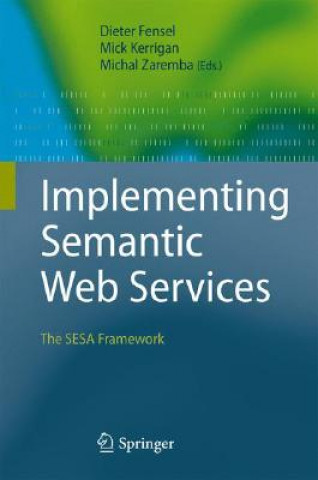
Code: 01569641
Implementing Semantic Web Services
by Dieter Fensel, Mick Kerrigan, Michal Zaremba
Service-oriented computing has become one of the predominant factors in IT research and development efforts over the last few years. In spite of several standardization efforts that advanced from research labs into industrial-stre ... more
- Language:
 English
English - Binding: Hardback
- Number of pages: 322
Publisher: Springer-Verlag Berlin and Heidelberg GmbH & Co. KG, 2008
- More about this

You might also like
-

Court of Thorns and Roses Hardcover Box Set
605.63 zł -5 % -

Harvard Business Review Project Management Handbook
127.32 zł -3 % -

The Selection 1-5 Box Set
233.30 zł -15 % -

Bowls of Goodness: Vibrant Vegetarian Recipes Full of Nourishment
93.17 zł -23 % -

Fixed Stars and Constellations in Astrology
85.52 zł -4 % -

Polish Tutor: Grammar and Vocabulary Workbook (Learn Polish with Teach Yourself)
139.01 zł -23 % -

Underwear
128.73 zł -14 % -

Show and Tell: Level 1: Student Book and Multi-ROM Pack
98.31 zł -2 % -

Myths & Legends
91.36 zł -14 % -

Kubernetes in Action
286.49 zł -

JavaScript Patterns
140.22 zł -5 % -

People Skills for Analytical Thinkers
98.92 zł -

Beyond Greed and Fear
188.27 zł -

Magic Ponies: Pony Camp
29 zł -23 % -

Glucose Revolution: The Life-Changing Power of Balancing Your Blood Sugar
125.61 zł -5 % -

How We're F***ing Up Our Planet
89.04 zł -11 % -

Hybrid Securities
564.63 zł -

Football Conditioning a Modern Scientific Approach
200.36 zł -

Ultimate 1 Year Old Activity Book
84.31 zł -

Waterfowl of North America, Europe, and Asia
197.54 zł -5 % -

Kredki ołówkowe Prestige 24 kolory w kasetce
40.69 zł -14 %
Give this book as a present today
- Order book and choose Gift Order.
- We will send you book gift voucher at once. You can give it out to anyone.
- Book will be send to donee, nothing more to care about.
More about Implementing Semantic Web Services
You get 166 loyalty points
 Book synopsis
Book synopsis
Service-oriented computing has become one of the predominant factors in IT research and development efforts over the last few years. In spite of several standardization efforts that advanced from research labs into industrial-strength technologies and tools, there is still much human effort required in the process of finding and executing Web services.§Here, Dieter Fensel and his team lay the foundation for understanding the Semantic Web Services infrastructure, aimed at eliminating human intervention and thus allowing for seamless integration of information systems. They focus on the currently most advanced SWS infrastructure, namely SESA and related work such as the Web Services Execution Environment (WSMX) activities and the Semantic Execution Environment (OASIS SEE TC) standardization effort. Their book is divided into four parts: Part I provides an introduction to the field and its history, covering basic Web technologies and the state of research and standardization in the Semantic Web field. Part II presents the SESA architecture. The authors detail its building blocks and show how they are consolidated into a coherent software architecture that can be used as a blueprint for implementation. Part III gives more insight into middleware services, describing the necessary conceptual functionality that is imposed on the architecture through the basic principles. Each such functionality is realized using a number of so-called middleware services. Finally, Part IV shows how the SESA architecture can be applied to real-world scenarios, and provides an overview of compatible and related systems.§The book targets professionals as well as academic and industrial researchers working on various aspects of semantic integration of distributed information systems. They will learn how to apply the Semantic Web Services infrastructure to automate and semi-automate tasks, by using existing integration technologies. In addition, the book is also suitable for advanced graduate students enrolled in courses covering knowledge management, the Semantic Web, or integration of information systems, as it will educate them about basic technologies for Semantic Web Services and general issues related to integration of information systems.
 Book details
Book details
Book category Books in English Reference, information & interdisciplinary subjects Library & information sciences IT, Internet & electronic resources in libraries
285.78 zł
- Full title: Implementing Semantic Web Services
- Subtitle: The SESA Framework
- Author: Dieter Fensel, Mick Kerrigan, Michal Zaremba
- Language:
 English
English - Binding: Hardback
- Number of pages: 322
- EAN: 9783540770190
- ISBN: 3540770194
- ID: 01569641
- Publisher: Springer-Verlag Berlin and Heidelberg GmbH & Co. KG
- Weight: 618 g
- Dimensions: 235 × 155 × 23 mm
- Date of publishing: 24. April 2008
Trending among others
-

Love's Executioner
81.69 zł -5 % -

Web Search Savvy
778.49 zł -

Wearable Technology
330.61 zł -

Marshmallow Test
85.52 zł -

Digital Library Programs for Libraries and Archives
472.96 zł -

IT for Librarians
206 zł -4 % -

Bibliographic Record and Information Technology
343.81 zł -

Advances in Cross-Language Information Retrieval
564.63 zł -

Innovative LibGuides Applications
401.84 zł -

Emerging Issues in the Electronic Environment
113.82 zł -

Library Technology Planning for Today and Tomorrow
511.24 zł -

Electronic Legal Deposit
414.63 zł -

Digital Literacy Unpacked
929.60 zł -

Electronic Databases and Publishing
778.49 zł -

Preserving Digital Materials
746.76 zł -

Using Mobile Technology to Deliver Library Services
646.13 zł -

Library Information Technology and Networks
1435.71 zł -

Fool's Gold
171.65 zł -

Subject Liaison's Survival Guide to Technical Services
226.55 zł -

WordPress for Libraries
609.76 zł -

Cloud Computing and Virtualization Technologies in Libraries
929.80 zł -

Library Automation in Transitional Societies
745.35 zł -

Planning and Implementing Electronic Records Management
482.93 zł -

Web Accessibility
482.93 zł -

Managing the Crowd
482.93 zł -

Delivering Impact with Digital Resources
500.46 zł -

Electronic Resources
513.86 zł -

Managing Digital Resources in Libraries
856.47 zł -

Digital Curation
414.22 zł -

Managing Digital Cultural Objects
895.25 zł -

Coding for Librarians
243.07 zł -

Fundamentals of Technical Services
347.13 zł -

Evaluation of Multilingual and Multi-modal Information Retrieval
564.63 zł -

Comparative Evaluation of Multilingual Information Access Systems
564.63 zł -

Advances in Information Retrieval
564.63 zł -

Social Information Retrieval Systems
955.99 zł -

When We Are No More
88.74 zł -23 % -

Creating Spatial Information Infrastructures
957.71 zł -

Electronic Library and Visual Information Research 2
208.42 zł -

Email For Library&Info Serv Pr
174.07 zł -

Data Visualization
535.41 zł -5 % -

Library Technology and Digital Resources
276.01 zł -

Information Literacy Beyond Library 2.0
483.23 zł -

100 Ready-to-Use Pathfinders for the Web
567.25 zł -

Information Retrieval Systems
564.63 zł -

Discover Digital Libraries
445.45 zł -

Knowledge Unbound
60.03 zł -

Learn Reference Work International Edition
239.65 zł -

Beyond Reality
462.28 zł
safisfied customers
Since 2008, we have served long line of book lovers, but each of them was always on the first place.
Copyright! ©2008-24 libristo.pl All rights reservedPrivacyPoučení o cookies



 21 million books
21 million books Delivery 12.99 zł
Delivery 12.99 zł (32) 444 93 66 (8-15.30h)
(32) 444 93 66 (8-15.30h)